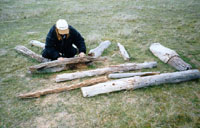Management activities that reduce habitat by removing fallen timber often deplete faunal diversity, whereas activities that enhance this feature can promote species diversity. To assess whether faunal habitat can be enhanced in grazed environments we monitored fauna usage of artificially placed fence posts in semi-arid grasslands and woodlands in Terrick Terrick National Park in Victoria.
 In total, 1131 posts were placed at 91 sites across major vegetation types in the reserve. The effect of habitat restoration was assessed by comparing faunal usage between new refuges and 271 old refuges that have lain in situ for > 15 years. Refuges were surveyed for vertebrate fauna monthly between June 2000 and January 2001.
In total, 1131 posts were placed at 91 sites across major vegetation types in the reserve. The effect of habitat restoration was assessed by comparing faunal usage between new refuges and 271 old refuges that have lain in situ for > 15 years. Refuges were surveyed for vertebrate fauna monthly between June 2000 and January 2001.
In total, 346 observations of 15 species from eight vertebrate families were recorded beneath refuges, including threatened species (Striped Legless Lizard, Tessellated Gecko and Curl Snake). There was no difference in species richness between sub-communities, however observations were more abundant in the woodland. The Tessellated Gecko, Boulenger’s Skink and Curl Snake were more abundant beneath old refuges, whereas the introduced House Mouse was more abundant beneath new refuges in widespread grassland sub-community.
There was evidence of seasonal and spatial dependence in new refuge usage patterns in eight species, particularly the Fat-tailed Dunnart and Curl Snake, with refuges at a given site showing increased utilisation over time. Relatively high use of new refuges suggests that these substrates might become more valuable for grassland fauna, especially reptiles and small mammals, as time progresses.
These results support other studies which demonstrate fauna habitat can be enhanced by placing refuges in areas where ground debris has been depleted by agricultural activities and also provides an opportunity to further investigate spatial and temporal patterns in faunal abundances and inter-specific interactions.